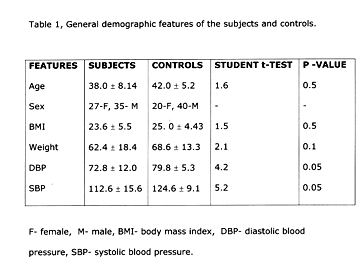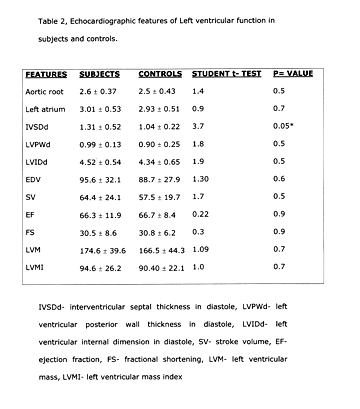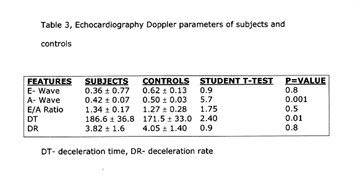
Danbauchi Sulei Solomon, FWACP
Consultant Cardiologist/Senior Lecturer,
Cardiology Unit, Department of Medicine,
Ahmadu Bello University Teaching Hospital, Zaria.
Sani Bala Garko, FWACP
Consultant Cardiologist/Lecturer I,
Cardiology Unit, Department of Medicine,
Ahmadu Bello University Teaching Hospital, Kaduna.
Alhassan Ahmed Mohammed, FMCP,
Consultant Cardiologist/Lecturer I,
Cardiology Unit, Department of Medicine,
Ahmadu Bello University Teaching Hospital, Zaria.
Oyati Albert Imhoagene, FMCP,
Consultant Cardiologist/Lecturer I,
Cardiology Unit, Department of Medicine,
Ahmadu Bello University Teaching Hospital, Zaria.
Correspondence:
DR DANBAUCHI S S,
CARDIOLOGY UNIT, DEPARTMENT OF MEDICINE,
ABUTH ZARIA, NIGERIA
e-mail:danbauchi@skannet.com
Along with antiretroviral (ARV) therapy can come an array of side effects, especially the long-term usage. Changes in body appearance and metabolic elevations are among the more wide-ranging side effects of combination therapy.(1) In high-income countries, the availability of highly active antiretroviral therapy (HAART) has greatly decreased the risk of illness from AIDS-related complications. Although HAART does prolong life, HAART also can have side effects. In some cases, users develop increased levels of fatty substances or lipids (cholesterol and triglycerides) and sugar in the blood.(2) It is postulated that these changes increase the risk of developing cardiovascular disease (CVD) heart attacks, strokes and other complications.(2,3) In developing countries ARV drugs are hard to come by, less than 1% of HIV positive subjects who would require it have access to these drugs. It was suggested that the provision of ART in sub-Saharan Africa is very big challenge, which must be handled urgently and carefully.(4) We evaluated the left ventricular function of these subjects on ARV drugs for 1-2 years using echocardiographic assessment.
Sixty-two subjects made up of 28 females and 34 males were recruited from retroviral clinic in our centre randomly. They must have satisfied the criteria of being on anti-retroviral continuously for 1 or 2 years. The ARV drugs include Niverapine 200 mg bid, lamuvidine 100 mg bid and stavudine 40 mg daily. The study was explained to the subjects and verbal consent for inclusion was obtained from each patient.
The personal data and demographic parameters were recorded. The subjects under went full clinical examination with emphasis to cardiac findings. All had transthoracic echocardiography (TTE) performed done in the left lateral decubitus position.
The following parameters were recorded: IVSd, LVIDd, LVPWd, IVSs, LVIDs and LVPWs. Left ventricular function assessment included ejection fraction (EF) and fractional shortening. Doppler studies were conducted at mitral inflow area, with E and A waves recorded, and the E/A ratio was calculated. Other cardiac findings including pericardial effusion, tumours were looked for and recorded. A control of 62 subjects (either blood donors or medical students who tested negative to retroviral screening) were recruited, and they also underwent similar evaluation as the study subjects, including echocardiography.
Quantitative data was reported as range and mean +/- SD (standard deviation) and qualitative data as percentages. The subjects were grouped in one and two year’s treatment groups. Student t test and chi-squared test were used the to compare the two duration of therapy groups in terms of demographic and echocardiographic findings.

The mean of age of the subjects was 38.00 +/- 8.14 with a range of 23 to 56 years while the mean age of the controls was 40.08 +/- 5.2 and a range of 25 to 55 years (t = 1.2, p = 0.5). Table 1 shows that the BMI's of both subjects and controls are similar and that the difference was not statistically significant (t = 1.52, p = 0.1). Eleven (17.7%) subjects had a BMI greater than 25.0 kg/m2 while 10 (16.2%) of the controls had a BMI greater than 25.0 kg/m2. The difference was not statistically significant (p = 0.8). The subjects weighed less than the controls and the difference was statistically significant (t = 2.1, p = 0.05). Table 1 also shows a lower mean diastolic blood pressure in subjects than controls (t = 4.2, p = .01). The systolic blood pressure shows a similar pattern of a lower mean systolic blood pressure in the subjects than in the controls (t = 5.2, p = 0.01). There were 25 patients on two years ARV treatment and 37 on one year ARV drug treatment. The subjects on ARV drugs had a mean CD4+ count of 182.3 +/- 48.4 before starting on the medications. It’s been difficult to do serial CD4+ counts when due because of the financial state of these patients.
Of subjects on antiviral drugs, five (11.4 %) had mild pericardial effusions and they all were on the drugs only one year. Amongst these subjects two had depressed ejection fraction. The presence of cardiovascular involvement when patients on anti-retroviral for one and two years were compared was not statistically significant (x2 =2.9, p = 0.6).
The subjects on ARV for 2 years had higher ejection fraction (p = 0.001) and fractional shortening (p = 0.001) when compared to subjects on one year of ARV drugs. The subjects on ARV drugs for one year had larger end-diastolic and end-systolic volumes when compared to those on ARV drugs for two years (p = 0.05 and 0.001 respectively). The EDV of subjects on ARV compared to the controls was not statistically different (t = 1.30, p = 0.1). The ESV, stroke volume, ejection fraction, fractional shortening, left ventricular mass/index were similar when the subjects were compared to controls (Table 2). Seven subjects on ARV drugs had diastolic dysfunction on echocardiography compared to three controls with same measured by reversal of E/A ratio or E/A ratio less than one. The mean E/A ratio for the subjects and controls were 1.24 +/- 0.17 and 1.27 +/- 0.28 (t = 1.75, p = 0.8). Two subjects on ARV drugs had a depressed ejection fraction compared to none in the subjects (p = 0.7).


Eight percent of the subjects had pericardial effusion, 10 % had diastolic dysfunction and 3.6 % had depressed ejection fraction. Studies have revealed that even though ARV drugs prolong life, cardiac involvement seemed not to change on long-term therapy.(12) The subjects on 2 years ARV had a better ejection fraction than those had the drug for a year. It can be postulated that ARV drugs help improve myocardial function. The end diastolic volume, end systolic volume, aortic root did not show a difference between the subjects and controls. The subjects also have shown a tendency of having a thicker interventricular septum, which could be explained by the number of the subjects that had hypertension. None of our subjects were on indinavir and nelfiinavir - drugs that have been associated with hypertension.(8) The left ventricular mass and index were not different, a longer follow-up should reveal the changes that occur in the muscle mass and geometry of the heart.
Trends have been seen with the increased rate of myocardial infarction with a longer duration of exposure to ART, which were similar to those expected on the basis of a change in known cardiovascular risk factors.(13) The authors concluded that the increase was due to ART-induced changes in conventional risk factors. Previous study findings suggest that the longer an individual is exposed to ART, the greater their risk for a cardiovascular event occurring 11. However, it must be kept in mind that the risk remains small compared with aged-matched controls. Whether ART causes the increased risk remains to be determined(14), but it has been suggested in the meantime, that aggressive modification of known coronary risk factors needs to be a mainstay of the treatment strategies, treatment needs to be individualized and drugs that are known to raise lipids need to be avoided by patients with known coronary risks.(15) In our setting strategies geared towards preventing the common cardiovascular disorder - hypertension, should be stepped up because some percentage of subjects have shown tendency of being hypertensives.
We conclude that the subjects have their life improved but the cardiovascular involvement in retroviral disease seems to persist i.e. pericardial effusion, low ejection fraction and diastolic dysfunction. Some of subjects seem to have gained so much weight to overweight and obesity levels. A proper cardiovascular risks assessment is also suggested to help identify our own peculiar factors.
Limitations: Longer longitudinal follow up will be required in our group of patients to determine the cardiovascular risk they are prone to on log-term therapy. Wide availability of anti-retroviral drugs will also allow for larger number of patients to be recruited to such a study to enable us draw far reaching conclusions.
1. Baril, L, Beucler I, Valantin MA, Bruckert E, Bonnefont-Rousselot D, Coutellier A, Caumes E, Katlama C, and Bricaire F. Low lipolytic enzyme activity in patients with severe hypertriglyceridemia on highly active antiretroviral therapy. AIDS 2000; 15: 415-417.
2. Krishnaswamy G, Chi DS, Kelley JL, et al. The cardiovascular and metabolic complications of HIV infection. Cardiology Review. September-October 2000;8(5): 260-268.
3. Holmberg s et al. Protease inhibitors and cardiovascular outcome in patients with HIV. Lancet 2002; 30,360.
4. Kassaye SG and Katzenstein D. HIV/AIDS care and treatment in sub-Saharan Africa. AIDS Rev 2003;5:195-204.
5. Carr, A, Samaras K, Chisolm DJ, and Cooper DA. Pathogenesis of HIV-1-protease-inhibitor-associated peripheral lipodystrophy, hyperlipidaemia, and insulin resistance. Lancet 1998; 351: 1881-1883.
6. Carr, A, Samaras K, Thorisdottir A, Kaufmann GR, Chisolm DJ, and Cooper DA. Diagnosis, prediction, and natural course of HIV-1 protease-inhibitor-associated lipodystrophy, hyperlipidemia, and diabetes mellitus: a cohort study. Lancet 1999; 353: 2093-2099.
7. Bonnett, E, Ruidavets JB, Tuech J, Ferrieres J, Collet X, Fauvel J, Massip P, and Perret B. Apoprotein C-III and E-containing lipoparticles are markedly increased in HIV-infected patients treated with protease inhibitors: association with the development of lipodystrophy. J Clin Endocrinol Metab 2001; 86: 296-302.
8. Hewitt RG, Thompson WMIV, Chu A, Hernandez F, and Shelton MJ. Indinavir, not nelfinavir, is associated with systemic hypertension when compared to no protease inhibitor therapy. Program and Abstracts of the 8th Conference on Retroviruses and Opportunistic Infections. February 4-8, 2001, Chicago, IL, Abstract 658.
9. Chase U Denimark. AIDS drugs cocktails may increase heart risk, WSJ, 2005 February 24.
10. Koppel K, Bratt G, Raj J. Sudden death in a patient in 2 years of HAART: a case report. AIDS 1999; 19:1993-4.
11. DeCastro, S, Migliau G, D'Amati G, Giannantoni P, Cartoni D, Kol A, Vullo V, and Cirelli A. Heart involvement in AIDS: a prospective study during various stages of the disease. Eur Heart J 1992; 13: 1452-1459.
12. Friis-Moller N, Weber R, Reiss P, et al. Cardiovascular disease risk factors in HIV patients: Association with antiretroviral therapy—Results from the DSD study. AIDS 2003; 17:1179-1193.
13. Pugliese, A, Isnardi D, Saini A, Scarabelli T, Raddino R, and Torre D. Impact of highly active antiretroviral therapy in HIV-positive patients with cardiac involvement. J Infect 2000; 40: 282-284.
14. Mary-Krause M, Cotte L, Partisani M, Simon A, and Costagliola D. Impact of treatment with protease inhibitor (PI) on myocardial infarction (MI) occurrence in HIV-infected men. Program and Abstracts of the 8th Conference on Retroviruses and Opportunistic Infections. February 4-8, 2001, Chicago, IL, Abstract 657.
15. Stein, JH, Klein MA, Bellehumeur JL, McBride PE, Wiebe DA, Otvos JD, and Sosman JM. Use of human immunodeficiency virus-1 protease inhibitors is associated with atherogenic lipoprotein changes and endothelial dysfunction. Circulation 2001;104:257-262.